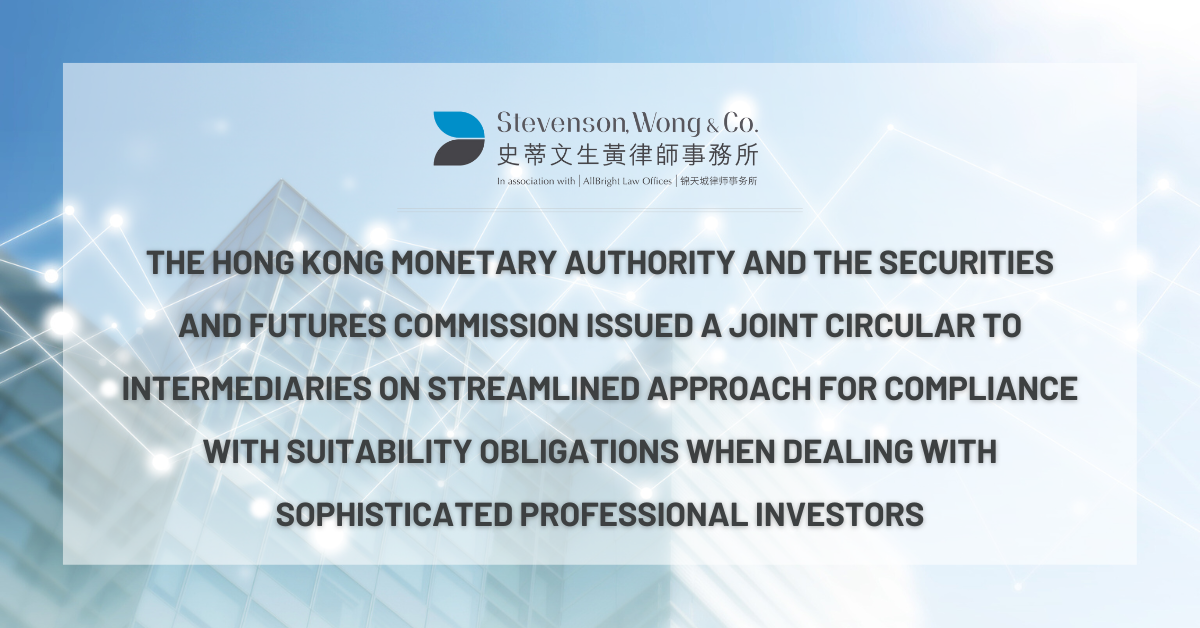Introduction
On 28 July 2023, The Hong Kong Monetary Authority (“HKMA”) and the Securities and Futures Commission (“SFC”) published a joint circular (“Circular”) on the streamlined approach for compliance with suitability obligations when dealing with sophisticated professional investors (“SPIs”) who possess higher levels of net worth and knowledge or experience (“Streamlined Approach”).

Background
Suitability assessment is a process by which intermediaries match investment products with the personal circumstances and risk tolerance of clients. To illustrate how suitability assessment should be conducted and to clarify the expected standards, on 23 December 2020, the HKMA issued the Frequently Asked Questions on Investor Protection Measures while the SFC issued the Frequently Asked Questions on Compliance with Suitability Obligations and Requirements for Complex Products. With a view to provide intermediaries with further guidance when dealing with SPIs, the HKMA and the SFC have jointly published the captioned Circular.
Under the Streamlined Approach, an intermediary is not required at a transaction level to match the SPI’s risk tolerance level, investment objectives and investment horizon, or to assess the SPI’s knowledge, experience and concentration risk. An intermediary may rely on information obtained from client during onboarding or know-your-client reviews and ascertain whether the client is qualified as an SPI. Where an intermediary is reasonably satisfied that the client exhibits the degree of sophistication and loss absorption ability of an SPI, it may apply the Streamlined Approach to allow the SPI to invest in a portfolio of investment products including but not limited to the high-risk investment products such as leveraged transactions.
The Streamlined Approach is summarized in the table below:
|
||
| A | Financial situation | An SPI should possess at the relevant date:
Note: A corporation with principal business of holding of investments and is wholly owned by one or more SPIs may be treated the same as the SPIs for the purpose of the guidance. |
| B | Knowledge or experience | Intermediaries should be reasonably satisfied that an SPI has the degree of sophistication required to understand the risks arising from being treated as an SPI. To do so, intermediaries should ascertain whether the SPI meets at least one of the following criteria:
|
| C | Investment objectives |
|
Intermediaries should only execute investment transactions for an SPI under the Streamlined Approach where the transactions fall within the (1) Product Categories; and (2) Streamlining Threshold (as defined below) specified by the SPI (“Eligible Investment Transactions”). |
||
| A | Product Category |
|
| B | Streamlining Threshold |
|
Procedures that could be streamlined by intermediaries for compliance with suitability obligations when dealing with SPIs in Eligible Investment Transactions. |
||
| A | For transactions with recommendation or solicitation executed under a Streamlined Approach | Intermediaries are NOT required to:
|
| B | For transactions in a complex product without recommendation or solicitation executed under a Streamlined Approach | Intermediaries are NOT required to:
Intermediaries could:
|
|
||
| A | SPI Assessment |
|
| B | Client acknowledgment | Prior to applying the Streamlined Approach when dealing with an SPI in Eligible Investment Transactions, the intermediaries should:
|
| C | Annual review |
In carrying out the annual review, intermediaries should remind the client in writing of:
|
Analysis and takeaways
The Streamlined Approach is anticipated to bring sophisticated investors and intermediaries increased flexibility as the full-blown suitability assessment would not be required before entering into each and every transaction and change of investment. Under the Streamlined Approach, SPIs would be able to respond to the market situation more efficiently and the approach is expected to be welcomed by the market, especially high-net-worth investors which possess certain level of knowledge and experience in terms of investment.
Nevertheless, intermediaries are reminded that they bear primary responsibilities for ensuring maintenance of appropriate standards of conduct by having effective internal control in place, especially for high-risk investment products such as margin trading. With the clear guidance from the HKMA and the SFC, it is foreseeable that the application of the proportionate Streamlined Approach by intermediaries would be facilitated without compromising compliance with suitability obligations of intermediaries.
Please contact our Partner Mr. Rodney Teoh for any enquiries or further information.
This news update is for information purposes only. Its content does not constitute legal advice and should not be treated as such. Stevenson, Wong & Co. will not be liable to you in respect of any special, indirect or consequential loss or damage arising from or in connection with any decision made, action or inaction taken in reliance on the information set out herein.
